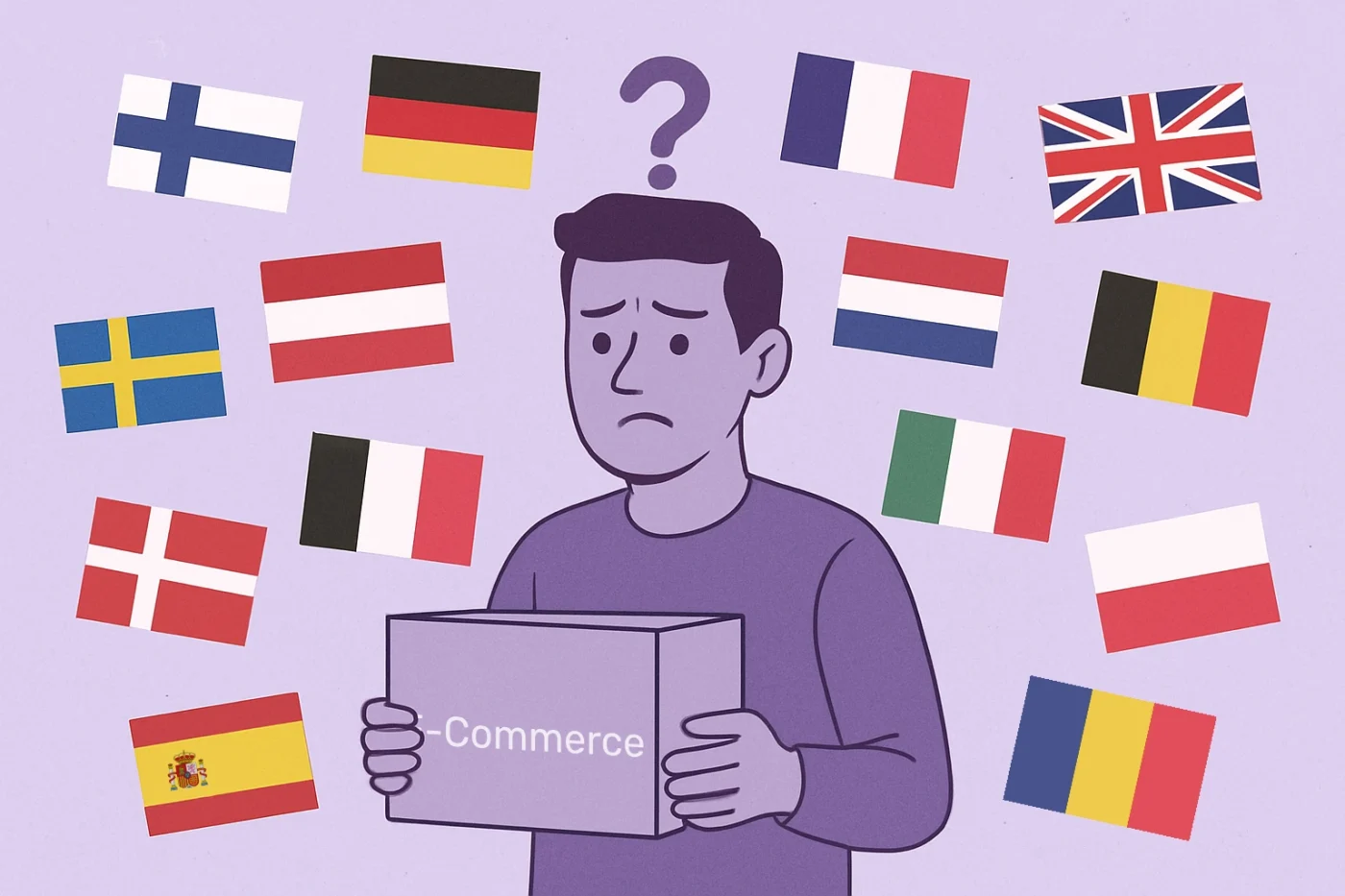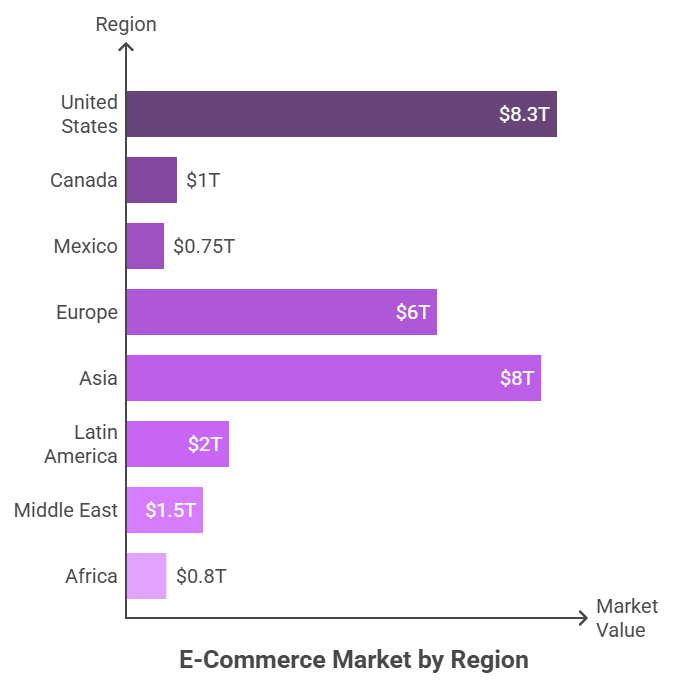5 Big Mistakes Ecommerce Stores Make When Going Multi-Language

With the accelerated growth of the global E-Commerce market multi-language is more needed than ever, but companies keep making big mistakes.
Currently, according to Cognitive Market Research, it is estimated to be worth about $28.53T and the US market accounts for only $8.38T of that… which is not even 30%.
If you want to scale your E-Commerce store, you must go global and translating your store into multiple languages becomes non-negotiable.
Some people might think that English is a well known language and people will buy, even if it’s not their native language… but this couldn’t be further from the truth. (only a small percentage of non-English speakers will buy products from English-only stores)
This is only one of the mistakes E-Commerce stores make when scaling into foreign countries, and today we will talk about the worst 5 mistakes stores make.
All the points will be based upon actual research and studies, so stay tuned!
Multi-Language Is Non-Negotiable

Going multi-language is a must, and there is absolutely no debate around this topic. Especially in area like the European Union where you cannot even operate as a business if your store is not in the local languages where you want to sell.
The European market is worth more than $6T and it’s definitely not a negligible amount.
To put this in context, that’s 71% of the US market, so you can almost double your potential market just by selling in Europe.
Plus, if you sell in French, it means you can also repurpose that translation for Canada, and since you sell in Spanish, you will be able to repurpose that for Mexico and Latin America.
You just added another $4T to your potential market, with minimal effort.
The Asian market is also huge, being evaluated at about $8T… so you’re missing out on a lot of traffic and sales, by selling only to English speakers from the US.
Data On Why Multi-Language Is A Must For E-Commerce
According to a study done by BigCommerce in April 2025 on the importance of multi-language in E-Commerce:
“English-only websites reach less than 25% of internet users worldwide. Leading ecommerce platforms like BigCommerce, Shopify, and WooCommerce recognize this need and offer solutions for multi-language stores”
The exact same BigCommerce studies mentions a Gallup survey on language preferences that reveals the following shocking findings:
- 9 out of 10 Internet users said that whenever given a choice, they preferred to visit a website in their own language
- 19% never browse in a foreign language
- 42% never make any purchases in languages other than their own.
A survey from CSA Research (July 7, 2020) on Multi-Language & Purchasing Behavior revealed:
- 65% prefer content in their language, even if it’s poor quality
- 67% tolerate mixed languages on a website
- 73% want product reviews in their language, if nothing else
- 76% prefer products with information in their own language
What shocked me the most is the fact that, just by having some poor quality translations, you can boost your traffic and sales so much.
According to a study by Shopify on Multi-Language & Ecommerce Localization, translation increases retailers’ conversion rates by 13% on average. and this is without taking into account the traffic boost from Search Engines.
Search Engines like Google serve sites in local languages with a priority because they are more relevant to the user and Google will offer them a better user experience.
Unbabel published a guide on optimizing your E-Commerce Sites for Multi-Language in which they stated:
Providing valuable and localized content establishes trust and credibility with your international customers, leading to higher search engine rankings and increased conversions.
It’s safe to say that you cannot get to the next level in E-Commerce without multi-language, and now you also know why it is so important.
Let’s get into the 5 big mistakes you must avoid when scaling with multi-language.
Mistake 1: Spending Too Much or Too Little
The first mistake E-Commerce stores make when scaling with multi-language is spending too much or too little on translation.
Some stores translate everything with DeepL, ChatGPT or any other AI translation tool.
Other stores opt for human translators.
Both options are bad, but let’s take them one by one and let me explain why.
Human Translators
If you have tons of money at hand and you don’t mind spending tens, hundreds of thousands of dollars, or even millions, on translating your store… go with this option.
The standard cost for a translation, from actual professionals, from English to German (the biggest E-Commerce market in Europe) will cost you about $0.29 per word.
YES! You read that right, they charge per word, and that’s the standard.
Other translators charge per page, but the most common pricing structure is per word.
Most E-Commerce products will have a product description of about 150 to 300 words.
Let’s go with 150 for the sake of simplicity.
To translate only one product, it would be $43.5, which doesn’t seem that much, right?
If you do all the paper work to sell in Europe, I image you want to sell in all the countries, so one translation won’t suffice and you would need about 27 more.
So, the total cost for translating a product will be about $1,174.5, for only one product.
The average E-Commerce store that’s ready to scale, usually have more than 1,000 products, so it can get quite expensive, super fast.
One of our clients, ComputerShop.eu translated over 9,000 products in 27 languages (now they have 4,500 in stock because the other products sold out) and their average product description length is about 100 words.
If they were to hire a human translator, they would’ve spent about $7,047,000 which is INSANE.
Instead, they translated all these products for about $8,000 and not to mention the time they saved, because our AI Translation Tool (that also generated product description where they are missing) delivered the translation infinitely faster than a human translator.
This was not meant to be a plug for your product, that’s why I won’t add any links, it was just to show you that stores really have this problem with human translators.
Not to mention the revision. Let’s say you want to change something, the translator will charge you again, and you will have to wait again… and if you don’t provide the whole context, he won’t be able to provide a good output… and it’s just a headache.
AI Translation Tools
If I just complained about human translators up to this point, this doesn’t mean I will just praise AI translation tools because they are obviously worse… but there’s a catch.
65% prefer content in their language, even if it’s poor quality.
I am not saying AI translation tools are good, most of the time they are not even good enough to use, but sometimes they give great results.
The main problem with them is not the cost, but it is their reliability. Sometimes the output is just on point, and sometimes it is completely off.
At Ovesio, we were able to collect tons of data on the reliability of AI translation tools, and the results will shock you. Tools like DeepL or ChatGPT are not even close to being the best ones.
If you’re looking to learn more about the best AI tools, here’s an article for you: What is the best AI translation tool for marketing?
In the ideal scenario, if you want to go with AI translation tools, instead of human translators, you would need some sort of algorithm that uses multiple translators at the same time, and then picks the best parts from each translation, and only then compiles the most accuracy one.
In fact, we do this at Ovesio, but that’s a conversation for another time.
We are here to talk about mistakes done when scaling with multi-language.
Mistake 2: Manually Managing Content
The second mistake E-Commerce stores make when scaling with multi-language is managing the translated content manually.
I beg you… DON’T DO THIS!
You will end up hiring entire teams just to manage translated pages which will be in folder and sub-folders and this will create a spiral of headaches. It will require massive amounts of manual labor or an expensive team of engineer to be able to get out of it.
Imagine creating, editing, monitoring, and updating 27 different pages for each product in your store… ComputerShop.eu had 9,000 products.
Imagine 243,000 different pages that must be managed manually.
A tool that creates these pages automatically for you, and then when you need to make an edit, you just edit the original version (in the original language) and the other languages change automatically. That would be a dream.
Mistake 3: Poor Multilingual SEO
If you don’t want to run ads in all the countries you will sell your products in, you must go for SEO, and since you transition from a certain language, you already have tons of articles, and product descriptions and resources you can use.
But don’t forget about SEO. Worst part? Most human translators don’t know SEO and if you hire one that knows, it will be even more expensive.
It is out of the discussion to do it manually for all translated pages, and you cannot just skip this part because you would miss on tons of traffic and sales from search engines.
Look for software that does the translation, content management and SEO automatically.
Mistake 4: Missing Product Descriptions
Another mistakes, way too many E-Commerce stores make when scaling with multi-language is skipping the product descriptions when translating the store.
They will just leave it empty, and translate only the title and product specifications.
Would you buy a product that has no description?
Is that store looking trust-worthy to you?
I know it wouldn’t trust an E-Commerce store that has missing product descriptions, because it looks lazy and the website looks straight up fake.
So make sure you add product descriptions for all the languages you translate your products in.
Mistake 5: Lack of Local Payment Methods
As we saw above, 9 out of 10 Internet users said that whenever given a choice, they preferred to visit a website in their own language.
That’s not the case only for information, but that’s also for payment processors.
Online shoppers expect familiarity, and they expect payment processors that they know and trust.
For example in Germany there are:
- Giropay – Bank transfer-based payment method, widely used.
- Sofort (by Klarna) – Instant bank transfer popular for e-commerce.
- Paydirekt – Online payment service from German banks.
- RatePAY – Offers invoice and installment payments.
- Computop – German payment gateway supporting local and international methods.
France has:
- Carte Bancaire (CB) – National card payment scheme.
- Paylib – Mobile payments backed by French banks.
- Ingenico (now Worldline) – French-founded PSP, major EU presence.
- Lemon Way – French fintech offering B2B marketplace payment solutions.
- HiPay – French PSP offering multi-channel payments.
In Latin America you can find:
- PayU LATAM
- Mercado Pago
- Kushki
Romania has:
- Netopia mobilPay – Most widely used payment gateway in Romania.
- PlatiOnline – Offers card and bank transfer options.
- PayU Romania – Local arm of PayU tailored for Romanian merchants.
- EuPlatesc (EuroPayment Services) – Supports local banks and card payments.
There are local payment processors and online shoppers recognize them. When they see a different payment processor that also sounds super-foreign they will not only raise on eyebrow, but also think twice if it’s safe or not to put in their credit card.
It’s important to offer payment options using their local processors, or use international ones like PayPal, Stripe Apple Pay, or Google Pay. But don’t expect low commissions.
Multi-Language E-Commerce FAQ
1. Do I really need to translate my store if I already have international traffic?
Yes. Just having international visitors doesn’t mean they’ll convert into buyers. Research shows that 42% of users won’t purchase from sites in other languages. Translating your store builds trust and increases conversions.
2. Can I rely solely on AI tools like DeepL or Google Translate?
Not reliably. While AI tools are fast and cheap, they often lack context and can produce awkward translations. Translation quality can swing wildly, and incorrect phrasing can damage credibility or create legal issues in regulated markets.
3. Is human translation always better?
Not always. It’s more accurate, but it’s also slow, expensive, and hard to scale. Revising or updating content is also costly and time-consuming. For stores with hundreds or thousands of products, manual translation becomes nearly impossible to maintain.
4. What’s the biggest SEO mistake stores make when going multilingual?
Ignoring multilingual SEO. Translating your content without optimizing keywords for each target market means you miss out on search traffic. Even great translations won’t rank if they’re not optimized for the local language and search habits.
5. What’s the fastest and most scalable way to manage multilingual content and updates?
Automation. You need a system that can:
- Translate content reliably
- Sync updates across all languages
- Handle SEO metadata per region
- Manage product descriptions and even generate them if missing
Why Ovesio Is the Ultimate Solution for Multi-Language E-Commerce
Most platforms and tools give you either speed or accuracy. Ovesio gives you both.
With Ovesio, you get access to an AI Inspector that doesn’t just blindly translate, it evaluates the quality of every translation and automatically combines outputs from multiple AI engines to deliver the most accurate, context-aware version possible.
Here’s what Ovesio helps you with:
- ✅ Automatic translation of entire stores (product pages, collections, descriptions)
- ✅ AI-generated product descriptions where they don’t exist
- ✅ Auto-syncing across 27+ languages
- ✅ Multilingual SEO optimization baked-in
- ✅ Elimination of manual content management
- ✅ One-click updates to translated pages
- ✅ Massive savings over human translation (90%+ cost reduction)
Whether you’re scaling to 5 new countries or 25, Ovesio gives you the infrastructure, intelligence, and automation to do it right, without breaking the bank or your backend team.
👉 Ovesio is your AI Translation Tool for Scaling E-Commerce (or explore the blog if you’re not ready to jump in).





